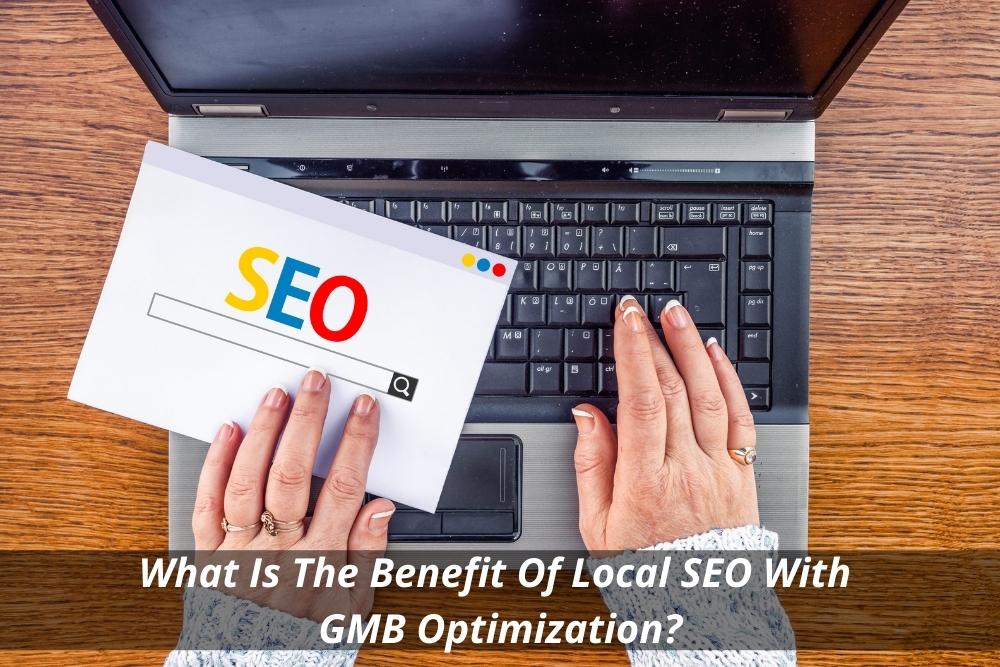Do you want to know what is the benefit of local SEO with GMB Optimization? As the world becomes increasingly digitized, businesses must adapt their marketing strategies to meet the needs of the modern consumer. Local SEO is a powerful tool that can help businesses reach new customers and grow their business. optimization?
Local SEO is the process of optimizing your online content for the purpose of getting found by local customers. It is an important part of any digital marketing strategy, as it helps you to rank higher in search engine results pages (SERPs) for searches related to your business.
There are many benefits to Local SEO, but some of the most important include:
– Increasing visibility in search engine results in pages (SERPs), which can lead to more website traffic and customer inquiries;
– Boosting brand awareness and reach within your local market;
– Helping you to compete with larger businesses by levelling the Local SEO playing field.
What are Local SEO and GMB optimization?
Local SEO is the process of optimizing your online content and presence to rank higher in search engine results pages (SERPs) for searches related to your business that are made from within a certain geographic area.
By optimizing your Local SEO, you can improve your chances of being found by potential customers who are looking for businesses like yours online. Local SEO optimization involves claiming and optimizing your Google My Business Account (GMB) listing, as well as making sure your website and other online properties are optimized for local search.
There are a number of factors that go into Local SEO, including:
– The quality and quantity of your online reviews
– The accuracy of your NAP (name, address, phone number) listings
– The relevance of your website and online properties to Local SEO keywords
– The distance between your business and the searcher
– The age of your website and online properties
If you want to improve your Local SEO, there are a number of things you can do, including:
– Claiming and optimizing your GMB listing
– Optimizing your website for Local SEO keywords
– Creating Local SEO-friendly content
– Getting more online reviews from happy customers
– Improving the accuracy of your NAP listings across the web.
By following these Local SEO tips, you can improve your chances of being found by potential customers who are searching for businesses like yours online.
How to get started with Local SEO and GMB optimization?
Local SEO is a process of optimizing your online presence to attract more business from local customers. It involves creating and optimizing your website and online listings (such as Google My Business) to make it easier for people in your service area to find and contact you.
Here are some tips to get started with Local SEO:
- Start by claiming and verifying your Google My Business listing. This is a free listing that allows you to control how your small business appears in Google Maps and Local search results.
- Make sure your NAP (name, address, phone number) information is consistent across all of your online marketing listings. Inconsistent NAP information can confuse search engines and potential customers, making it harder for them to find you.
- Optimize your website for Local SEO by including your city and state in your title tags, meta descriptions, and H1 headers. You can also create Local landing pages to target specific service areas.
- Generate positive customer reviews on popular review sites like Yelp, Google, and Facebook. Positive reviews help improve your Local SEO ranking and can influence potential customers who are researching your business.
- Use Local keywords in your content. For example, if you’re a plumber in Los Angeles, you’ll want to use Local keywords like “plumbers in Los Angeles” or “Los Angeles plumbers” in your website copy and blog posts.
Tips for optimizing your local business website
If you’re running a local business in SEO Sydney, it’s essential to make sure your website is optimized for Local SEO. By doing so, you’ll ensure that your site appears as high as possible on search engine results pages (SERPs) for searches related to your business.
Here are some tips for optimizing your local business website:
- Make sure your NAP (name, address, and phone number) is consistent across all platforms. Local search engines use this information to verify the accuracy of your listing, so it’s important that the NAP is identical everywhere it appears.
- Claim and populate your Google My Business page. This is one of the most important Local SEO listings for your business, as it appears prominently in SERPs.
- Optimize your website for Local SEO keywords. Conduct keyword research to find out which Local SEO keywords are most relevant to your business, and then include them throughout your site’s content (in the meta tags, titles, descriptions, etc.).
- Generate local reviews and testimonials. Positive reviews from satisfied customers can do wonders for your Local SEO ranking. Try to encourage customers to leave reviews on popular review sites like Yelp and Google My Business.
- Build local citations. Local citations are mentions of your business on other websites, with or without a link back to your site. The more high-quality local citations you have, the better your Local SEO will be.
How to set up your GMB profile for the best results?
If you’re serious about Local SEO, then you need to make sure your Google My Business (GMB) profile is set up correctly. GMB is a powerful tool that can help you increase your visibility in local search results, and it’s absolutely essential for any business that wants to be found online.
Unfortunately, many businesses either don’t have a GMB profile at all, or they have one that is incomplete or incorrect. In this article, we’ll show you how to set up your GMB profile for the best results.
The first step is to claim your listing. If you don’t do this, someone else could claim it and change the information on your listing. To claim your listing, go to google.com/business and search for your business. If you see a “Claim this business” button, click it and follow the instructions.
You can check to see who claimed it by clicking on the “Info” tab (it’s the second tab from the left). If you see an email address that doesn’t belong to you, you’ll need to contact Google and request ownership of the listing.
The next step is to verify your listing. This is important because it helps Google rank high and know that your business is legitimate. To verify your listing, Google will send a postcard with a verification code to your business address. Once you receive the postcard, simply enter the code on your listing’s verification page.
If you can’t verify your listing yourself, you can also have Google verify it for you. To do this, click on the “Request Verification” link on your listing’s verification page. Google will then call your business and give you a verification code that you’ll need to enter on the page.
Once your listing is verified, you can start filling out your profile. The first thing you’ll want to do is add some basic information about your business, such as your business name, address, and phone number. You can also add a brief description of your business, as well as some photos and videos.
It’s important to make sure that all of the information on your GMB listing is accurate and up-to-date. Incorrect or outdated information can hurt your Local SEO efforts, so be sure to double-check everything before you hit the “publish” button.
Finally, don’t forget to take advantage of GMB’s Insights feature. This tool provides valuable data about your listing, such as how many people have viewed it, clicked through to your website, or called your business. Reviewing this data regularly can help you understand what’s working well and what needs improvement.
How to track your Local SEO progress and measure success?
There are a number of ways to track your Local SEO progress and measure success. Here are some of the most effective:
- Check your website traffic. One of the best ways to gauge Local SEO success is by checking your website traffic. Look for increases in both overall traffic and targeted local traffic. You can use Google Analytics or another similar tool to track this data.
- Check your search engine rankings. Another key metric to track is your search engine rankings for relevant keywords. Use a tool like Google Search Console or Moz Local to track your progress over time.
- Check your online reviews. Online reviews are increasingly important for Local SEO success. Make sure you’re monitoring sites to see what customers are saying about your business.
- Check your click-through rates. Another important metric to track is your click-through rate (CTR) from Local SEO listings. This data will give you insight into how effective your Local SEO efforts are at driving traffic to your website.
- Check your leads and sales. Finally, be sure to track leads and sales generated from Local SEO traffic. This will give you the most accurate picture of overall Local SEO success.
By tracking these key metrics, you’ll be able to get a good sense of how well your Local SEO efforts are paying off. Be sure to track progress over time so you can see long-term trends and adjust your strategy accordingly.
If you are looking for ways to grow your business, Local SEO is a great place to start. GMB optimization can help you to achieve higher rankings in SERPs, reach more local customers, and boost your bottom line. Contact us today to learn more about how we can help you optimize your Local SEO strategy.


